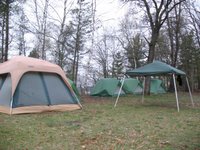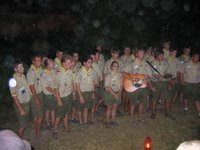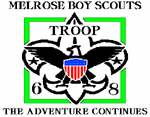 Boy Scout Troop 68 began using Eureka tents in the late 1980’s. We began using the Alpine Meadows four man tents until Eureka discontinued making that model. Then we moved on to that popular model with Scout troops known as the Timberline. Along the way we also bought a few little two man backpacking tents.
Boy Scout Troop 68 began using Eureka tents in the late 1980’s. We began using the Alpine Meadows four man tents until Eureka discontinued making that model. Then we moved on to that popular model with Scout troops known as the Timberline. Along the way we also bought a few little two man backpacking tents.
We have had very good luck with the Eureka tent line. Yes, they cost a bit more then some other brands out there but the Eurekas are made with good quality materials. The tents have survived a lot of Boy Scout camping abuse. The main problem we have had is boys losing the aluminum stakes that come with the tents.
We have discovered a few tips for taking care of tents over the years. For example, when camping in grazing woodlands keep the cattle away from the campsite. Make sure the boys do not play football or other ball games next to the tents. Do not erect tents downwind and near campfire rings. Pack and store tents after they are completely dry, and not when they are soaking wet.
Last weekend was the troop’s first camping trip of the new year. When we arrived at Parker Scout Reservation we had to set up the tents in a light rain, which did not make the Scouts very happy. Did I mention that we were camping on the side of the lake receiving the full strength of gale force winds?
For thirty-eight hours the tents were pounded by winds averaging twenty to thirty miles per hour, with gusts in the fifty to sixty miles per hour range. We staked the tents down with larger stakes then the ones that came with the tents, and even moved them Saturday morning so we could try blocking the wind with our cars and pickups. There were times during the evening hours while laying in our sleeping bags that we thought the tents would come down around our heads. The tent files flapped so fast and loudly it was tough to fall asleep.
When it came time to pack the tents Sunday morning we were glad the tents were Eureka. All the tents were still standing. They had done their job of providing us shelter during the rain and wind storms. However, almost every tent had received some sort of damage. A few pole assemblies were bowed beyond repair. Several rings found at the corners of the tents were stretched and would need to be replaced. Surprisingly, the tent fabric held up fine and did not rip. Only the metal portions of the tents received any damage.
This week I will have to go online and find the replacement parts from somewhere, and then find the time to pull the tents apart and start the repair work. That sounds like a good job for the quartermasters to help with. Now, where did I put the troop’s credit card?


